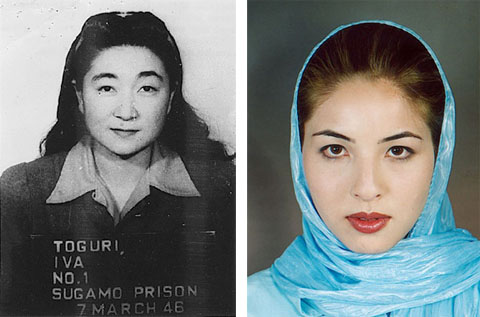Mixed Message: On Cultural Hybridity in James Cameron's 'Avatar'
11 Sep 2010

Must we always polarize in order to polemicize? Are we trapped in a politics of struggle where the representation of social antagonisms and historical contradictions can take no other form than a binarism? Can the aim of freedom of knowledge be the simple inversion of the relation of oppressor and oppressed, centre and periphery, negative image and positive image? Is our only way out of such dualism the espousal of an implacable oppositionality or the invention of an originary counter-myth of radical purity?
—Homi Bhabha, The Location of Culture
I DIDN'T THINK I'd write an essay about a mainstream Hollywood film that was produced by Fox Movies, but I want to review Avatar in regards to hybridity and look at it under the filter of the cinematic representation of mixed heritage identities. Since the 2009 release has lured audiences back into film theaters[1] (if only to experience the revival of a much advertised 3D cinema hype), I am curious about the socio-political implications of these representations.
The film's plot is built on the idea of fixed borders between binary worlds: between good and bad, between here and there, between us and them. At center stage is a character that goes back and forth between these two worlds and whose fate hinges on the fact that he must ultimately choose which world he belongs to. To complicate the story on the level of identity, the protagonist has two bodies, one real and one synthetic, and he cannot be in both bodies at the same time. Since his experience of the world is informed by the body the protagonist is inside of, he is literally defined by a split self: he oscillates between the two bodies, and while he inhabits one of the two, the other is unconscious.
From within one or the other body, the protagonist sees the two opposing worlds from reverse perspectives and develops a sense for what is "good" and what is "bad." Over the course of the film, he will not only change his political outlook, but experience a reversal of values: the real becomes unreal, the right becomes wrong, the desirable becomes undesirable, the inconceivable becomes conceivable, etc. He will develop and transform his identity, and he will determine which side of the border to stand and fight on.The nature of such representation is deeply problematic and always comes at the expense of the trans-cultural: the one of mixed heritage; the one whose being is comprised of both 'worlds'; the one whose cultural identity is ambiguous; the one who is neither one of us nor one of them but more than both; the one that refuses to deny either of the two worlds; and the one who rejects having his life dictated and defined by societal pressures, norms, and political classifications.
Despite the complex technology and extravagant production resources, the language employed in Avatar is very simple. Not only does it reintroduce old racial stereotypes of the transnational individual as spy and traitor, but the film firmly establishes the essentialist framework that all beings must be placed within defined worlds whose borders cannot be transcended, thus eliminating the possibility of residing in, belonging to, and being made up of more than one world.
Avatar: A hybrid movie about a hybrid future?
The first thing heard is the voice-over of the main protagonist Jake Sully, played by Sam Worthington, retelling a recurring dream that he has had ever since he was injured in a war. "When I was lying there in the VA hospital with a big hole blown through the middle of my life, I started having these dreams of flying. I was free."[2]
This idea of freedom, or the vision of a colorful utopia, is a world placed on a planet many light-years away from planet Earth; a paradise called Pandora, where everyone lives in peace with each other, with nature, and the environment. The planet's ecosystem is thriving. The blue humanoids who inhabit this world, called the Na'vi, use a kind of braided 'hair-extension' to physically connect to trees, horses, dragons, and panthers, just like one would plug in a firewire cable to connect a computer to an external hard-drive.
The lush green forest of Pandora is reminiscent of rainforests in the Amazon, centennial trees of California's Redwood forests, tropical flora in Asia, and the jungles in Central Africa. In fact, its forest looks like it could be a mixture of all the forests on Earth--it is a magical place with magical powers. As Dr. Grace Augustine, "exobiologist and head of the Avatar Program", played by Sigourney Weaver, explains in the film: "There is some kind of electro-chemical communication between the roots of trees. Like synapses between neurons...It's a network, and the Na'vi can access it. They can upload and download data, memories from the trees"[3] by plugging in what I casually call their "hair-extension," which is directly connected to their own neural system.
This image, particularly of plugging into a system through the back of the head, the uploading and downloading of data, memories and information, brings to mind a film that came ten years before: The Matrix. Connecting to an all-encompassing network is not the only way in which Avatar corresponds to the trilogy, which was advertised as "a hybrid of live action and computer-generated special effects, and its melding of low-budget Hong Kong kung fu action and big budget Hollywood bang."[4] As cultural theorist Leilani Nishime writes, Keanu "Reeves, the film's multi-racial star, provided a visual metaphor for the hybrid future. The danger and allure of crossed boundaries pervade every aspect of the film, from its plot to its visual punch."[5]
Avatar operates with visual metaphors for a hybrid future as well, although even more so than the cyber-punk film of the late 90s, hybridity in Cameron's film is manufactured digitally with sophisticated CGI technologies. While mixed race actor Reeves delivers a decidedly positive representation of mixed heritage people, cultural hybridity in Avatar does not have a human face. Instead, it is super-human: artificially generated by computer graphics, synthetic in its construction, and imaginary in the audience's perception.
Still, in Cameron's film, the crossing of boundaries permeates the film visually, physically, metaphorically, and is explicitly incorporated into the dialog several times. And just like "[in The Matrix] two central and diametrically opposed factions enact familiar narratives of Neocolonialism."[6] The dichotomy is established between two planets, between a utopian and a dystopian place: between planets Pandora and Earth. The story is set in the year 2154 when globalization has spun out of control, where everything has been subsumed under the authority of one giant military-industrial regime that will stop at nothing to please its shareholders with "good quarterly statements." Planet Earth is dying, so humans set out to other planets to look for energy resources they need.
The Matrix is not the only film Avatar pays tribute to. In fact, there are countless references included in the film, from its plotline, structure, and action heroes to its visual metaphors, morals, and political messages. Quotations range from small gestures to entire genres resulting in a mash-up of tropes: from rope-climbing, tree-jumping Tarzan; marveling at oversized vegetation as in Alice in Wonderland, to man-driven combat machines like in the Japanese anime Gundam and The Matrix: Revolutions.
The visual representations tap deeply into a collective memory of cinema history: It feels like we've seen it all before, the "good" action hero, the boy flying dragons like in the Neverending Story, the distant galaxy where planets are at war with each, and of course, Alien others--rendering a hybrid recombination of different cinematic languages, elements, and visions.

Me02R Messer "mecha suit" illustration from the Tomino Yoshiyuki
Gundam novel Hathaway's Flash, 1989.[7]

The "Armored Personell Unit" (APU) worn in the Wachowskis'
The Matrix Reloaded, and The Matrix Revolutions, 2003.[8]

The "Mitsubishi MK-6 Amplified Mobility Platform" (AMP) suit
in James Cameron's Avatar, 2009.[9]
Human dystopia vs. hybrid utopia
Hybridity is omnipresent; everything on Pandora is a mixture of known elements from planet Earth. The horses in the film look like a mix of different animals: they have a long tongue like an anteater, a muzzle like a tapir, striped legs like a zebra, scales like a snake, and gills like a shark. The principle of hybridity is applied to all living things.
The Na'vi culture itself is like a big blend of different world cultures: their hair is done in a fashion obviously suggestive of cornrows, as worn by many different African people. The feathers, beads, bows and arrows seem prompted by all kinds of indigenous cultures; body decorations look like they're lifted from different Amazonian tribes; the coming-of-age ritual is inspired by the Maori people of New Zealand; the spirituality of the Na'vi seems to be a mix of Animism and Totemism. The language sounds like a mixture that contains elements grabbed from different world languages.
Thus the Na'vi people could be seen as one big collage patched together from all kinds of historically marginalized people, those constructed as the "Other" in the discourse of Colonialism. While the appearance of the Na'vi clearly is alien, their cultural characteristics are ethnically ambigiuous, revealing just enough attributes so that different people can identify with them, and delivering just enough markers that one can read different stories into them, and see specific historical, social or political issues represented.
The opposing camp: planet Earth. The audience finds out little about what Earth will actually look like in the future because the story exclusively takes place in space and on Pandora. The dystopian scenario is merely constructed by stark contrast: While life on Pandora is shown in the most beautiful (at nighttime fluorescent) color spectrum, human life is governed by monstrous machines, capital, and greed, and accordingly, is shown in drab gray, concrete and metallic colors.

Left: Valkyrie taking off from "Hell's Gate," the main facility for all human colonial activities on Pandora.[10]
Right: Nighthawk, the U.S. military's first stealth fighter jet, decomissioned in 2008[11]
If the Na'vi represent a hybrid of what was historically constructed as "Other," then the Earthlings can be seen as a hybrid of all that stands for "the American Empire." References range from the "Shock and Awe" campaign in Iraq, napalm used in Vietnam, the fall of the World Trade Center, and the occupation of Afghanistan, to the political ultimatum imposed on Iran over the concern for atomic weapon development. Further themes that are hinted at are massive deforestation in Africa, Asia, and South America, as well as drilling for oil.
Straddling these two opposing worlds is the main protagonist Jake Sully, who goes back and forth between the space camp of the humans and the jungle of Pandora, between his human body and his hybrid body.
The split identity of Jake Sully
In the first five minutes of the film, as Jake arrives on Pandora for the first time on a military spacecraft, his interior monologue reveals: "One life ends, and another begins." While the voice is laid under images that show the cremation of his twin brother Tom, this phrase forecasts the storyline of the film: death of the human Jake, birth of the Na'vi Jake.
This main protagonist is introduced as a physically impaired man, a veteran who's lost his ability to walk. However, he is independent of others. As the film unfolds, the identity of this man changes from more human to more Na'vi. Jake's human body increasingly deteriorates, he eats less and less, he suffers from insomnia, his beard grows (giving him a scruffy appearance), he doesn't shower, and he probably smells really bad. Towards the end, the human Jake Sully is too weak to lift himself up and is entirely dependent on the help of others.
On the other hand, the Jake Sully who becomes the leader of the indigenous people inhabits a hybrid body, which was grown from an artificially inseminated, genetically modified human cell, infused with Na'vi DNA. Sully does not take on a native name like "Dances With Wolves" to mix with the indigenous population as a "white man." He does not pretend to be one of them; he is de facto one of them; although, to be specific, he is half human, half Na'vi.
Mixed metaphors: body and identity
Originally engaged to work as a spy, Jake is supposed to learn how to talk, live, and be like the indigenous population. This is in order to convince the Na'vi to relocate, so that the military-industrial complex can gain access and exploit the natural resources located under the local village.
The first time Jake becomes his Na'vi avatar can be seen as the symbolic birth of the very synthetic hybrid. The theme of childhood development is depicted during the first half of the film, in which Jake has "first contact" with the local population. Still with a human identity, he is helpless in his new body and environment. He would not have survived if the princess of the clan, Neytiri, had not saved his life. When Jake tries to thank Neytiri, she responds that Jake is "like a baby, making noise, not knowing what to do."
After receiving a sign from the spiritual goddess of Pandora, Neytiri takes Jake back to Hometree and her clan. Despite Jake "passing" as Na'vi by looks, the clan leader recognizes his status, declaring that an "alien smell fills [his] nose." He is inclined to kill him when Mo'at, the clan's spiritual leader, arrives.
After briefly inspecting Jake's appearance, Mo'at takes a wooden spike and pricks Jake's body, licking the blood. This can be interpreted as a reference to the one-drop-rule. The one-drop rule is a colloquial term in the United States for classification as black, for individuals with any African ancestry; it is what was historically regarded as "hypodescent," the automatic racial and social assignment of children of a mixed parentage. In other words, a person was legally considered "black" if the individual had any African ancestry.
Visually, one is reminded that Jake Sully not only passes as Na'vi, he also has "native" blood in him. He not only looks almost exactly like the other Na'vi; he has all the magical attributes and agency that the Na'vi have. However, in the film, Jake needs to be taught how to awaken these powers. This is perhaps reminiscent of a bi-cultural person "returning" to a country of heritage for the first time. While things seem familiar, a culture of heritage may still need to be acquired and re-learned.
One progressively witnesses the developmental stages of a young Na'vi, from the first horseback-riding lessons all the way to Jake's initiation into the tribe, making him a member, and granting him the right to speak and be heard. Perhaps this is equivalent to the naturalization of an immigrant: gaining the right to speak up, to vote, and to have a say in politics.
Jake is always in transition; the scenes are intercut between his experience with the Na'vi and the return into the human world. His spirit travels back and forth between the worlds, and the borders between the bodies blur.
The more he develops his Na'vi identity, the less he identifies with the humans. The more he feels at home in the Na'vi body, the less he is convinced that he is doing the right thing as a human being. In a transitory moment, the audience hears Jake's interior monologue: "Everything is backwards now, like out there is the true world and in here is the dream." Eventually, Jake switches sides and decides to fight for the welfare of Pandora, rendering him a traitor to the humans.
"You've crossed the line."[12]
Cultural transgression as treason
The stereotype of the transnational identity as traitor is nothing new. Arguably the most famous example in US media history is that of Tokyo Rose, the projection of a female "Asian" woman with an understanding of both American and Japanese cultures. Part war-inflicted fantasy, part political scapegoat, and part self-imposed tragedy; at the core of the myth lies the story of an individual named Iva Toguri, whose transnational affiliation turned into a seemingly never ending despair, as she was caught between two nations during World War II.
Another, more recent example that attracted international attention is that of American journalist Roxana Saberi, who is of Iranian and Japanese heritage. Saberi was conducting research in Iran on a forthcoming book when she was arrested in 2009 on charges of espionage.

Left: Iva Toguri[13] Right: Roxana Saberi[14]
Both Toguri and Saberi represent public figures who crossed national boundaries. Toguri was forced to make radio announcements as an American Prisoner of War on Radio Tokyo; Saberi works as a journalist for a number of news agencies such as National Public Radio and the BBC. In both cases, transnational individuals were accused of being spies. Both women were stranded in one of two countries of heritage, both women were innocent, and both women were convicted of treason.
In both cases, media representation played a pivotal role in the fate of the two individuals. In Toguri's case, the power of media led to long-term imprisonment; media pressure and international petitions led to the revision of Saberi's case, subsequently leading to her release and return to the US.
These two cases are extreme examples of people who fell victim to their transnational heritage, and who were mistrusted on account of their intercultural agency.
Most transnational individuals who are rooted in different nations, communities, and other categorical groups often experience the difficulty of providing evidence, proving authenticity, of declaring cultural belonging. The lived experience of people with mixed heritage is often that of being subject to scrutiny, of being discriminated against by both sides for lack of proof of "cultural authenticity."
Hybridity behind borders
Once Jake has made up his mind that he will abandon his human mission, he chooses to reveal his status as a spy. Devastated by the news, and with the impending doom of the human military strike, Neytiri rejects Jake and exclaims "You will never be one of the people."[15]
This very line exemplifies the deeply problematic nature of placing cultural hybridity as a universe behind borders, on another planet. As represented in Avatar, Pandora's hybridity relies on the concept of an essential, authentic core that requires the elimination of all that is considered foreign or "true" to itself. Despite Jake's very real hybrid status within a hybrid body that has "real" Na'vi blood and DNA, his half human heritage is what renders him "foreign," "fake," and "corrupted." This imagined Utopia on planet Pandora reveals the very mechanisms of exclusion that constitute essentialist thinking and practices.
Ultimately, despite the hybrid technology employed in making the film, the transnational actors hidden behind blue masks[16], the mixing of cinematic languages and tropes, and despite all the obvious references to hybridity theory, the film does nothing more than divide a universe between good and evil. It doesn't help that the colonizers in the film, whose key figures represent "white Americans," are the bad guys.
There is no space in this kind of scenario for the consideration of borders as something constructed by human thought and action, and for the de-construction of the self/other binary opposition.
If Jake's "split self" conceptually allows for his own self-reflexive, critical agency to develop and flourish, by assuming opposing positions within his human and hybrid bodies, it only helps him determine which side of the fence to stand on. And if the purpose of deliberately reversing perspectives is supposed to be the moral of Cameron's science fiction tale, then it only repeats, in fact, reinforces the opposition between the two terms.
Perhaps an interesting representation of trans-cultural identity in Avatar is a short clip within the three-hour film, a clip that's exactly four seconds long. It shows the somewhat abstract and mysterious first transfer of Jake Sully's consciousness from his human body into his hybrid body.
In the clip, the critical agent doesn't assume either of opposing positions, he is "neither one or the other but something else besides."[17]
press play to see the clip
◊
Notes
[1] According to Businessweek.com, Avatar's Box Office Sales passed US$2 Billion in Worldwide Sales in January 2010, making it the top grossing motion picture to date.
[2] Avatar. Dir. James Cameron. Perfs. Sam Worthington, Zoe Saldana, Sigourney Weaver. DVD. Fox Movies, 2009.
[3] Ibid.
[4] Leilani Nishime, "The Matrix Trilogy, Keanu Reeves, and Multiraciality at the End of Time" in Mixed Race Hollywood, ed. Mary Beltran and Camilla Fojas (New York University Press, 2008), 290
[5] Ibid.
[6] Ibid., 299
[7] "Gundam Illustration." Online image. Gearsonline. http://www.gearsonline.net/gundam/hathaway.php
[8] "Model of APU." Online image. http://www.jeansimard.com
[9] "Model of AMP." Online image. Avatar Wiki. http://james-camerons-avatar.wikia.com/wiki/AMP_Suit
[10] "Valkyrie taking off from Hell's Gate." Online image. Avatar Wiki. http://james-camerons-avatar.wikia.com/wiki/Valkyrie
[11] The Valkyrie visually reminded me of the Lockheed F-117 Nighthawk which was widely publicized in the first Persian Gulf War. "Nighthawk makes its final flight." Lockheed Martin. Online Image. 6.Sept 2010. Airforce Times. http://www.airforcetimes.com/news/2008/04/airforce_nighthawk_f117_042108w/
[12] This is the first line General Quadrich says to human Jake Sully after hybrid Jake Sully's first attempt at protecting Na'vi culture.
[13] "Mug Shot of Iva Toguri in Sugamo Prison." Online Image. Wikipedia. http://en.wikipedia.org/wiki/File:Iva_Toguri_mug_shot.jpg
[14] "Portrait of Roxana Saberi." Online Image. National Press Photographers Association. http://nppa.org/news_and_events/news/2009/04/saberi02.html
[15] Avatar. Dir. James Cameron. Perfs. Sam Worthington, Zoe Saldana, Sigourney Weaver. DVD. Fox Movies, 2009.
[16] The actresses in key Na'vi roles have a transnational background: Zoe Saldana who plays Princess Neytiri has a Dominican mother and Puerto Rican father and was raised both in the United States and the Dominican Republic. C. C. H. Pounder, who plays mother Mo'at, was born in British Guiana and raised in England, and the U.S.
[17] Homi Bhabha. The Location of Culture. (Routledge, 1994) 313